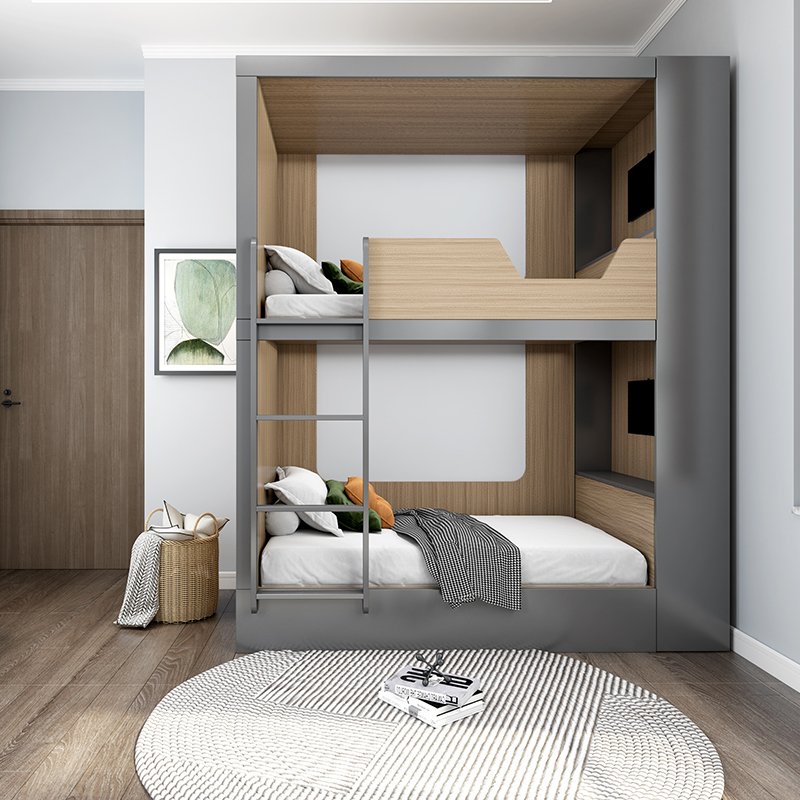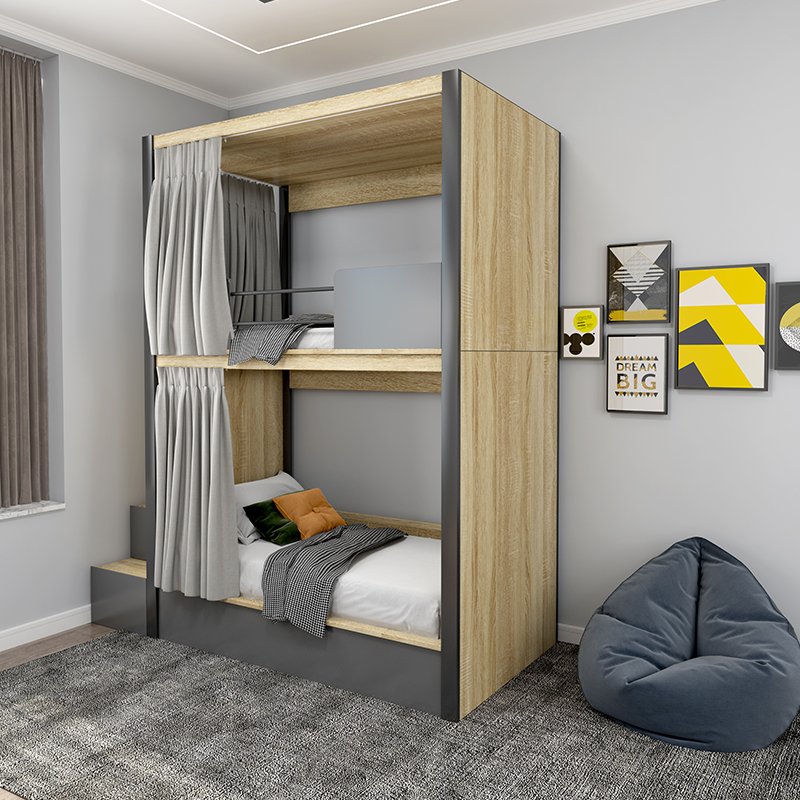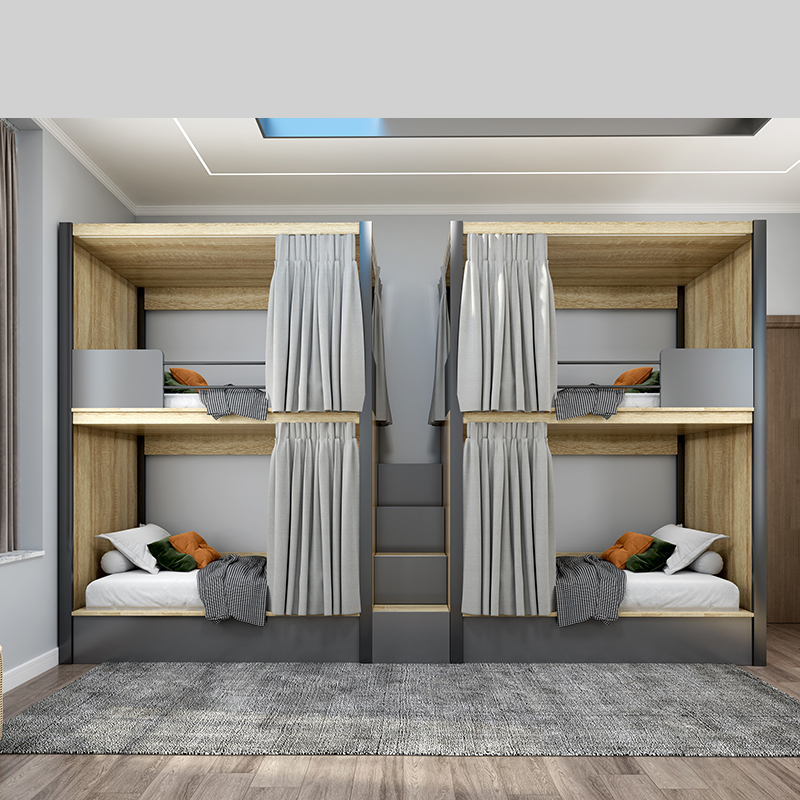Wooden bunk beds are a popular choice for many families, providing a space-saving and versatile solution for shared bedrooms or accommodating guests. The sturdy construction and timeless appeal of wooden bunk beds make them a practical and stylish addition to any home. In this comprehensive guide, we will explore the different types, safety considerations, design options, factors to consider when choosing, maintenance tips, and budget considerations for wooden bunk beds. Let’s dive in and discover the wonderful world of wooden bunk beds!
Introduction
Wooden bunk beds are not just functional pieces of furniture; they are also a source of excitement and adventure for children. They create a cozy and comfortable space where siblings or friends can bond and create lasting memories. Additionally, wooden bunk beds are a great option for guest rooms or vacation homes, as they maximize sleeping capacity without sacrificing style or comfort.
In this guide, we will provide you with all the information you need to make an informed decision when choosing wooden bunk beds for your home. From safety considerations to design options, we will cover every aspect to ensure that you create a secure and stylish sleeping area that meets your family’s needs.

Part 1: Safety Considerations for Wooden Bunk Beds
Safety is paramount when it comes to bunk beds, especially when children are involved. Here are some essential safety considerations to keep in mind:
1. Importance of Safety Measures and Regulations
When purchasing wooden bunk beds, it is crucial to ensure that they meet safety standards and regulations. Look for beds that comply with industry safety guidelines, such as those set by the Consumer Product Safety Commission (CPSC) or ASTM International. These standards ensure that the beds are designed and manufactured with safety in mind.
2. Proper Assembly and Installation Guidelines
Follow the manufacturer’s instructions carefully when assembling and installing the bunk beds. Pay close attention to the recommended weight limits and adhere to the suggested age restrictions. Improper assembly or installation can compromise the structural integrity of the beds and pose risks to the occupants.
3. Age-Appropriate Considerations and Weight Limits
Consider the age and size of the children who will be using the bunk beds. Younger children may be better suited for lower bunk beds, while older children can safely use the top bunk. Be aware of weight limits specified by the manufacturer and ensure that they are not exceeded to prevent accidents or structural damage.
Part 2. Different Types and Designs of Wooden Bunk Beds
Wooden bunk beds come in a variety of types and designs, each offering its own set of benefits and considerations. Let’s explore the most common options:

Standard Twin-over-Twin Bunk Beds
Standard twin-over-twin bunk beds are the classic choice for many families. These beds feature one twin-size bed stacked on top of another, with a ladder or staircase providing access to the top bunk. Twin-over-twin bunk beds are great for children of similar ages or for maximizing sleeping capacity in limited spaces. They offer a simple and space-efficient design that is easy to fit into any room decor.
1. Features and Benefits
- Space-saving: Twin-over-twin bunk beds maximize vertical space, making them ideal for smaller rooms or shared bedrooms.
- Versatile: The compact size allows for easy placement in various room layouts.
- Cost-effective: Twin mattresses are typically more affordable than larger sizes.
- Easy transition: As children grow, the bottom bunk can be used as a standalone bed if desired.
2. Suitable for
- Siblings sharing a room
- Sleepovers and accommodating guests
- Kids or teens who want a fun and functional sleeping arrangement
Twin-over-Full Bunk Beds
Twin-over-full bunk beds feature a twin-size bed on top and a full-size bed on the bottom. This design offers more sleeping space on the lower bunk, making it suitable for older children or teenagers who may prefer a larger bed. Twin-over-full bunk beds are also a great option for guest rooms or vacation homes, providing flexibility in accommodating guests of varying ages and sizes.
1. Advantages and Considerations
- Extra space: The full-size bottom bunk offers more room for comfortable sleep.
- Versatile: The larger bottom bunk can accommodate both children and adults.
- Guest-friendly: Twin-over-full bunk beds are perfect for guest rooms, providing options for individuals or couples.
- Size considerations: Keep in mind that twin-over-full bunk beds may require more floor space due to the larger bottom bunk.
2. Ideal for
- Older children or teenagers who desire more sleeping space
- Guest rooms or vacation homes accommodating guests of various ages and sizes
L-Shaped or Loft Bunk Beds
L-shaped or loft bunk beds are designed to maximize space efficiency and functionality. These beds feature a lofted bed on top, leaving room underneath for a desk, storage, or additional seating. L-shaped bunk beds have the top and bottom bunks arranged at a right angle, forming an “L” shape. These designs are perfect for creating a multifunctional area where children can sleep, study, and relax.
1. Space-Saving and Versatile Designs
- Versatile configurations: Loft beds can be combined with a variety of furniture arrangements, such as a desk, bookshelf, or futon.
- Efficient use of space: By utilizing vertical space, L-shaped or loft bunk beds free up floor area for other activities.
- Study and storage areas: The space underneath the loft bed can be customized to include a desk, shelves, or drawers, providing a dedicated study or storage area for children.
- Privacy considerations: L-shaped bunk beds offer some separation between the top and bottom bunks, providing a sense of privacy and personal space.
2. Ideal for
- Children or teenagers who need a dedicated study space
- Rooms with limited floor space seeking efficient storage solutions
- Maximizing functionality and creating a versatile living area
Triple Bunk Beds
Triple bunk beds are designed to accommodate three sleepers in a single structure. These beds are ideal for families with multiple children or for guest rooms that require additional sleeping capacity. Triple bunk beds are available in various configurations, with different combinations of bed sizes and arrangements.
1. Accommodating Three Sleepers Efficiently
- Space efficiency: Triple bunk beds offer a compact solution for maximizing sleeping capacity without sacrificing floor space.
- Sibling bonding: Triple bunk beds provide an opportunity for siblings to sleep and bond together.
- Stability considerations: Due to the increased weight and height, it is essential to ensure the structural stability of the bed and adhere to weight limits specified by the manufacturer.
2. Considerations for Stability and Space Requirements
- Structural stability: Triple bunk beds should be constructed with reinforced frames and secure guardrails to ensure safety and stability.
- Ceiling height: Make sure the room has adequate ceiling height to accommodate the height of the triple bunk bed.
- Space considerations: Triple bunk beds may require more floor space due to their larger footprint.
Part 3. Factors to Consider When Choosing Wooden Bunk Beds
Choosing the right wooden bunk bed involves considering various factors to ensure that it meets the needs of your family and fits seamlessly into your space. Here are some essential factors to keep in mind:

1. Quality and Durability
Investing in a high-quality wooden bunk bed will ensure longevity and safety. Look for beds made from solid hardwoods, such as maple, oak, or pine, as these materials offer durability and structural integrity. Check the manufacturer’s reputation and read customer reviews to gauge the overall quality of the bed.
2. Safety Features and Stability
Check for safety features such as sturdy guardrails, secure ladders or staircases, and proper spacing between slats to prevent entrapment. The bunk bed’s construction should be solid and stable, with reinforced joints and a robust frame. It is essential to ensure that the bed meets safety standards and guidelines to guarantee the well-being of its occupants.
3. Space and Room Layout
Evaluate the available floor space and ceiling height in the room where the bunk bed will be placed. Consider the dimensions of the bunk bed, including its height, width, and length, to ensure that it fits comfortably in the designated space. Taking accurate measurements beforehand will help you choose a bunk bed that fits perfectly.
4. Storage and Organization
If storage is a concern, consider bunk beds that incorporate storage options such as drawers or shelves. These built-in storage solutions provide a convenient way to keep the room organized and free from clutter. Evaluate the storage capacity and accessibility of the bunk bed to determine if it meets your family’s needs.
5. Design Aesthetic and Versatility
Wooden bunk beds come in various designs and finishes, allowing you to select a style that matches your room decor. Consider the overall design aesthetic, color schemes, and finishes that align with your preferences. Additionally, think about the bed’s versatility and its potential to adapt to changing needs or room configurations in the future.
Part 4. Maintenance and Care for Wooden Bunk Beds
To ensure the longevity and safety of your wooden bunk bed, it is essential to follow proper maintenance and care guidelines. Here are some tips to keep your bunk bed in top condition:
- Regular cleaning and dusting: Gently clean the bed with a soft cloth or duster to remove dust and debris. Avoid using harsh chemicals or abrasive cleaners, as they can damage the wood finish.
- Protecting the wood from scratches and damage: Use coasters or felt pads under items placed on the bunk bed to prevent scratches. Avoid placing hot items directly on the wood surface.
- Ensuring proper mattress support and rotation: Check the mattress supports regularly to ensure they are secure and in good condition. Rotate the mattresses periodically to promote even wear and prolong their lifespan.
Part 5. Budget Considerations and Where to Buy Wooden Bunk Beds
Wooden bunk beds are available in a wide range of price points to suit different budgets. When establishing your budget, consider factors such as quality, size, design, and additional features. Research reputable retailers and manufacturers that specialize in wooden bunk beds. Read customer reviews and compare prices to find the best value for your investment. Additionally, consider exploring secondhand options or refurbished bunk beds, which can offer cost-effective alternatives without compromising quality or safety.
Conclusion
Wooden bunk beds provide a practical and stylish solution for maximizing sleeping capacity in shared bedrooms or accommodating guests. By considering safety measures, different types and designs, factors like quality and durability, maintenance tips, and budget considerations, you can select the perfect wooden bunk bed for your family. Create a cozy and functional sleeping area that sparks joy and fosters lasting memories for your loved ones. With careful planning and consideration, a wooden bunk bed can become the centerpiece of a comfortable and inviting room. Sweet dreams await!

